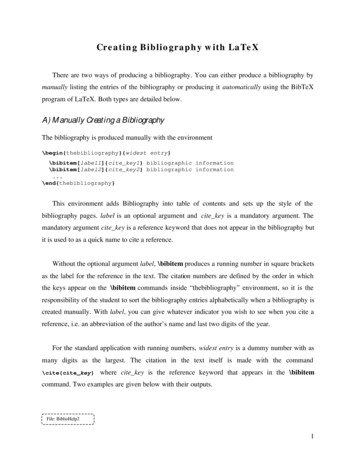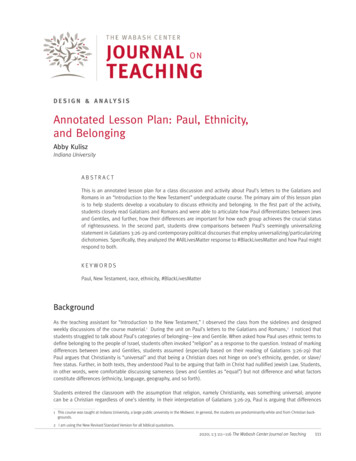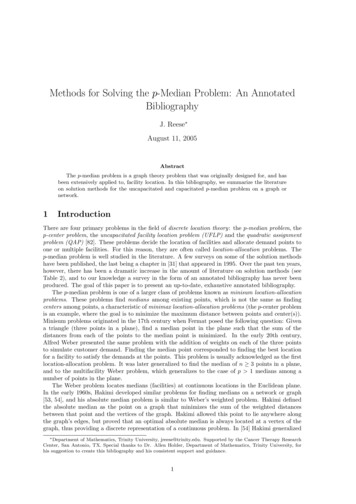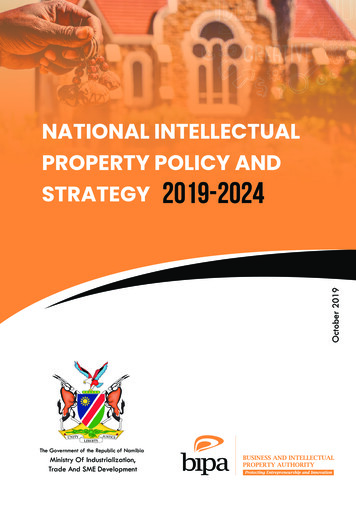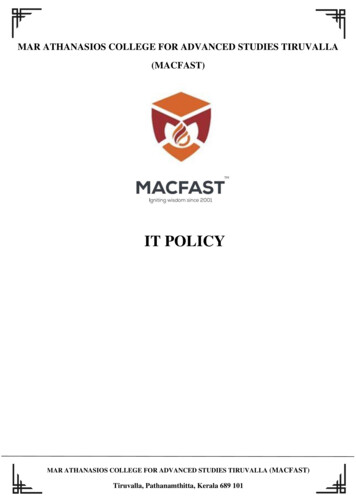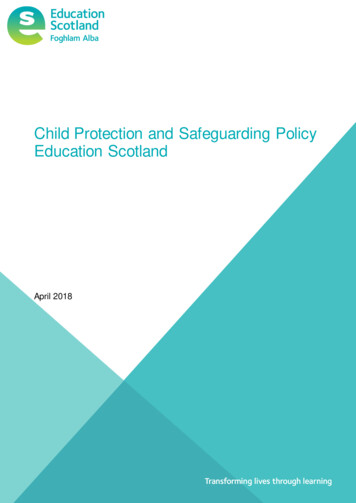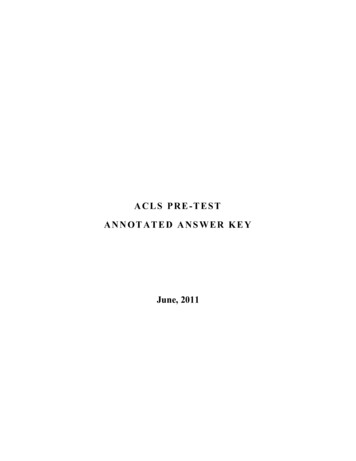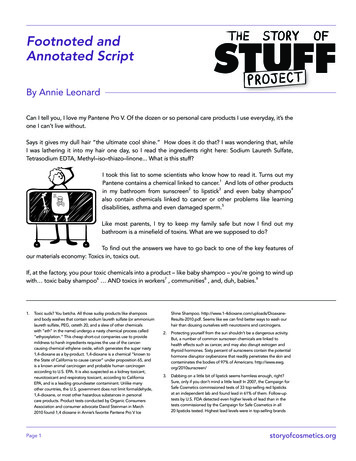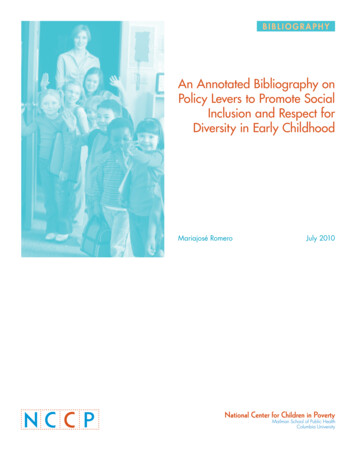
Transcription
BibliographyAn Annotated Bibliography onPolicy Levers to Promote SocialInclusion and Respect forDiversity in Early ChildhoodMariajosé RomeroJuly 2010
The National Center for Children in Poverty (NCCP) is the nation’s leading publicpolicy center dedicated to promoting the economic security, health, and well-beingof America’s low-income families and children. Using research to inform policy andpractice, NCCP seeks to advance family-oriented solutions and the strategic use ofpublic resources at the state and national levels to ensure positive outcomes for the nextgeneration. Founded in 1989 as a division of the Mailman School of Public Health atColumbia University, NCCP is a nonpartisan, public interest research organization.An Annotated Bibliography on Policy Levers to Promote Social Inclusionand Respect for Diversity in Early ChildhoodMariajosé RomeroAuthorAcknowledgementsDr. Mariajosé Romero is associate research scientist atNCCP, where her research examines the intersections ofclass, race, ethnicity, gender, immigration status and abilityin structuring disparities in early education and early schoolprocesses – specifically, early chronic school absenteeism,student mobility, teacher absenteeism and mobility – andchild outcomes, as well as ways to redress those disparitiesthrough a social inclusion and respect for diversity framework.This resource is part of a project funded by Bernard van LeerFoundation.Copyright 2010 by the National Center for Children in Poverty
An Annotated Bibliography on Policy Leversto Promote Social Inclusion and Respect forDiversity in Early ChildhoodMariajosé RomeroThis annotated bibliography includes research andpolicy books, articles, reports, and other resourcesreporting findings and lessons learned on theviability and effectiveness of various policy strategies to infuse a social inclusion and respect fordiversity (SI & RD) perspective in early childhoodeducation in the U.S.There has been in the past two decades a proliferation of efforts to: 1) establish policies that promoteteachers’ development of skills and knowledge towork with diverse children and families; attract ahighly qualified, diversified early childhood workforce; 2) improve their working conditions andcompensation; 3) equalize access to high qualityECE experiences; and 4) bridge the gap in childoutcomes among racial, ethnic, and income groups.Equally important have been efforts to promotethe formation of diversified leadership in the ECEfield. These efforts are aimed in varying degrees atinfusing a SI & RD perspective in ECE. Questionsremain, however, regarding the quality of theresearch foundation in which those efforts rest; theextent to which their implementation is consistentwith their underlying principles; their impact andcost-effectiveness at various levels (that is, child,peer group, family, teacher, classroom, organization,and community); their applicability and viability indifferent contexts; or how various policy levers areNational Center for Children in PovertyJuly 2010interrelated and could be used in a coordinated wayto support SI & RD goals.The bibliography presents each citation followedby a brief description, organized according to thefollowing broad topical categories: Policies that Impact on the Early ChildhoodEducation Workforce: Training and certification;Training program accreditation; Professionalstandards of ethics; Recruitment and retention;Professional development; Policies that Impact on the Early ChildhoodEducation Setting: Provider program licensing;Provider program accreditation; Quality Ratingsand Improvement Systems; Policies that Impact on Early Childhood EducationOutcomes: Early learning standards and guidelines; State assessments; and Leadership in early Childhood Education.Because of the complexities of the issues involved,this resource does not include the literature onpolicy levers related to language of instruction andhome language, nor those related to access to andfinancing of early childhood education in the U.S.3
Policies that Impact on the Early Childhood Education WorkforceTraining and Certification Dennehy, Julie. 2006. Setting the Stage for a YouthDevelopment Associate Credential. Houston, TX:Cornerstones For Kids.A review of efforts to create a professional credential for workers in out-of-school time child careprograms. Florida Children’s Forum. 2004. From Research toPolicy: Professional Development for Those WhoCare for and Educate Florida’s Children. FinalReport for Research Conducted to Assess PostSecondary Early Childhood Teacher PreparationPrograms in Florida. Tallahassee: FloridaChildren’s Forum.A study of the number and characteristics,including faculty and requirements, of programsin Florida offering early childhood teachingdegrees, based on a survey of institutions ofhigher education. FPG Child Development Institute. 2007.Preparing Culturally Competence Early ChildhoodTeachers FPG Snapshot No. 37. Chapel Hill, NC:FPG Child Development Institute.A summary of a study examining effectivepractices for helping early childhood educatorsdevelop cultural competency and improve theirclassroom learning environments. Jennings, Todd. 2007. Addressing Diversity inU.S. Teacher Preparation Programs: A Survey ofElementary and Secondary Programs’ Prioritiesand Challenges from Across the United Statesof America. Teaching and Teacher Education:An International Journal of Research and Studies23(8): 1258-1270.A survey of how multicultural education isaddressed in 142 public university elementary andsecondary teacher preparation programs acrossthe United States and of program coordinators’views of the challenges to including diversitytopics. Lekies, Kristi. 2007. Preparing Qualified Teachersfor Infants and Toddlers: The Role and Function of4Higher Education Teacher Preparation Programs.Cornell Early Childhood Program Policy BriefNo. 2. Ithaca, NY: Cornell University, College ofHuman Ecology, Early Childhood Program.A discussion of the background and results of theNew York Early Childhood Teacher PreparationStudy in terms of recruiting early childhoodeducation students to work with infants andtoddlers, preparation for these students, andspecific coursework required by programs to helpthese students develop specific skills. Lim, Chih-Ing. 2009. Cultural and LinguisticDiversity in Early Childhood Teacher Preparation:The Impact of Contextual Characteristics onCoursework and Practica. Early ChildhoodResearch Quarterly 24(1): 64-76.A study of the association between the amount ofdiversity coursework/practica in early childhoodteacher preparation programs and the diversityof the area in which the program is located, thegovernance and type of program, the presenceof non-white faculty, and the accreditation statusof the program, based on existing data about 449Bachelor’s level teacher preparation programs. Lobman, Carrie. n.d. Toward a Unified Systemof Early Childhood Teacher Education andProfessional Development: Conversations withStakeholders. New York: Foundation for ChildDevelopment.An examination of the experiences and perceptions of those involved in the creation of a newsystem of teacher preparation and professionaldevelopment in New Jersey, based on focus groupinterviews with preschool teachers, professionaldevelopment providers or administrators, teachereducators, and state policymakers. National Association for the Education ofYoung Children. 2001. NAEYC Standards forEarly Childhood Professional Preparation: InitialLicensure Programs. Washington, DC: NationalAssociation for the Education of Young Children.NAEYC’s standards for the preparation of earlychildhood professionals, intended for higherAn Annotated Bibliography Policy Levers to Promote Social Inclusion and Respect for Diversity in Early Childhood
education programs that prepare practitioners atthe initial licensure or certification level (usually abaccalaureate or master’s degree). Ray, Aisha. 2006. Preparing Early ChildhoodTeachers to Successfully Educate All Children: TheContribution of Four-Year Undergraduate TeacherPreparation Programs. New York: Foundation forChild Development.A study of whether early childhood teacherbachelor’s degree requirements meet the developmental and educational needs of children withspecial needs, racial and ethnic minority children,children from low-income families, immigrantchildren, and second language learners. Washington, Valora. 2008. Role, Relevance,Reinvention: Higher Education in the Field of EarlyCare And Education. Boston: Wheelock College,Aspire Institute.A discussion of the role of early childhoodcredentials in qualifying the early childhoodworkforce, the relevance of higher educationprograms to quality caregiving, and the ability ofhigher education programs to adapt and meet theneeds of the early childhood workforce. Whitebook, Marcy; Sakai, Laura; Kipnis, Fran;Almaraz, Mirella; Suarez, Esther; Bellm, Dan.2008. Learning Together: A Study of Six B.A.Completion Cohort Programs in Early Care andEducation: Year 1 Report. Berkeley: University ofCalifornia, Berkeley, Center for the Study of ChildCare Employment.Findings from the first year of a five-year longitudinal study of six cohorts of students participatingin California early childhood education B.A.completion programs, in which small groups ofstudents pursue a bachelor’s degree together andreceive support services. Whitebook, Marcy. 2005. Time to Revamp andExpand: Early Childhood Teacher PreparationPrograms in California’s Institutions of HigherEducation. University of California, Berkeley,Center for the Study of Child Care Employment.A survey of institutions of higher education thattrain adults to teach children under the age of fivein California.National Center for Children in PovertyTraining Program Accreditation Ray, Aisha. 2006. Preparing Early ChildhoodTeachers to Successfully Educate All Children:The Contribution of State Boards of HigherEducation and National Professional AccreditationOrganizations. New York: Foundation for ChildDevelopment.A study of the diversity-related content andlanguage in state boards’ of higher education andprofessional accreditation organizations’ earlychildhood teacher standards.Professional Standards of Ethics Lochhead, Andrew. 2001. Reflecting onProfessionalization in Child and Youth Care.Child & Youth Care Forum 30(2): 73-82.A child care provider’s personal reflections onthe pursuit for professionalism (that is, child careprovider training, qualifications, and ethics) inthe child care field. Mattingly, Martha A. 1995. DevelopingProfessional Ethics for Child and Youth CareWork: Assuming Responsibility for Quality ofCare. Child & Youth Care Forum 24(6): 379-391.A description of the development of professionalethics in the child and youth care field in NorthAmerica. Mattingly, Martha A. 1995. Ethics of Child andYouth Care Professionals: A Code Developedby the Draft Committee for the InternationalLeadership Coalition for Professional Child andYouth Care. Child & Youth Care Forum 24(6):371-377.A description of a code of ethics developed byNorth American Child and Youth Care to addressthe psychological, social, cultural, spiritual andbiological needs of children and their families. National Association for the Education of YoungChildren. 2005. Code of Ethical Conduct andStatement of Commitment. Washington, DC:National Association for the Education of YoungChildren.5
University of California, Berkeley. Center forthe Study of Child Care Employment. 2008.Early Childhood Educator Competencies: ALiterature Review of Current Best Practices, and aPublic Input Process on Next Steps for California.Berkeley: University of California, Berkeley,Center for the Study of Child Care Employment.A review of states’ practices for developing a set ofcompetencies for early childhood educators andfeedback from California’s early care and education field on developing a set of educator competencies for California.Professional Development Erikson Institute. 2004. The Field of EarlyChildhood Education Professional Development:Implications for Teaching, Research and Policy:Cantigny Conference Report. Chicago: EriksonInstitute.Proceedings of a conference on developing anearly childhood education workforce in whichevery child has access to a teacher with a bachelor’s degree. Hains, Ann H. 2000. Moving Towards CrossCultural Competence in Lifelong PersonnelDevelopment: A Review of the Literature. CLASTechnical Report No. 3. Champaign: University ofIllinois at Urbana-Champaign.An exploration the early childhood interventionworkforce, with a focus on the need for a culturally and linguistically diverse workforce to bettersuit the needs of children, and recommendationsfor such improvements. Lowenstein, Amy. E.; Ochshorn, Susan;Kagan, Sharon L.; Fuller, Bruce. 2004. TheEffects of Professional Development Efforts andCompensation on Quality of Early Care andEducation Services. Policy Brief II. Denver, CO:National Conference of State Legislatures.An examination of the professional developmentcompensation of early childhood teachers withexamples of state efforts and policy approaches forstate decision makers to consider.6Recruitment and Retention Annie E. Casey Foundation. School Readiness,Culture, and Language Working Group. 2006.Getting Ready for Quality: The Critical Importanceof Developing and Supporting a Skilled, Ethnicallyand Linguistically Diverse Early ChildhoodWorkforce. Oakland: California Tomorrow.A policy paper on the importance of increasingdiversity in the child care and early educationworkforce. Center for Law and Social Policy. 2009. Supporta Diverse and Culturally Competent Workforce.Washington, DC: Center for Law and SocialPolicyState policy recommendations for recruiting,maintaining, and supporting a diverse and culturally competent child care and early educationworkforce. Enochty, Marie; Farris, Marcia; Sockabasin,Lisa; St. Victor, Nicole. 2005. Essential toQuality: Supporting Cultural Competence inthe Department of Early Education and CareRegulated Workforce. Cambridge, MA: The SchottFellowship in Early Care and Education.A discussion of the implications of increasingcultural and ethnic/racial diversity inMassachusetts for the cultural competence,training and professional development requirements of the child care and early educationworkforce. Holm, Just; Janairo, Rolland; Jordan, Theresa;Wright, Nida. (n.d.). Where Are the Men?Promoting Gender Diversity in the MassachusettsEarly Childhood Workforce. Cambridge, MA: TheSchott Fellowship in Early Care and Education,The CAYL Institute.A discussion of the status of men in early careand education in Massachusetts, in light of recentworkforce development policy recommendationsin the state. Kagan, Sharon L.; Brandon, Richard. N.; Ripple,Carol. H.; Maher, Erin J.; Joesch, Jutta M. 2002.Supporting Quality Early Childhood Care andEducation: Addressing Compensation andInfrastructure. Young Children 57(3): 58-65.An Annotated Bibliography Policy Levers to Promote Social Inclusion and Respect for Diversity in Early Childhood
A framework for determining the infrastructurecost of universal early care and education foryoung children and adequate compensation forcaregivers. Matthews, Hannah. 2008. Supporting A DiverseAnd Culturally Competent Workforce: ChartingProgress For Babies In Child Care Research-BasedRationale. Recommendation No. 5. Washington,DC: Center for Law and Social Policy.An overview of research on the importance ofa diverse and culturally competent child careand early education workforce for healthy childdevelopment, with policy recommendations forrecruiting, maintaining, and supporting a diverseand culturally competent child care and earlyeducation workforce. United States Administration for Childrenand Families. Office of Planning, Researchand Evaluation. 2007. Working Towards aRecommended Common Core of Measures ofEarly Childhood Professional Development: Issuesand Preliminary Recommendations: White Paper[Draft]. Washington, DC: U.S. Administrationfor Children and Families, Office of Planning,Research and Evaluation.A survey of issues related to the limitations ofexisting measures of early childhood professionaldevelopment, with preliminary recommendationsfor addressing areas of difficulty. Whitebook, Marcy; Kipnis, Fran; Bellm, Dan.2008. Diversity and Stratification in California’sEarly Care and Education Workforce. ResearchBrief. Berkeley: University of California, Berkeley,Center for the Study of Child Care Employment.A policy brief discussing the stratification byeducational level and job role of the ethnic andlinguistic diversity of California’s ECE workforce,based on data from the Workforce Study. Whitebook, Marcy. 2003. Turnover BegetsTurnover: An Examination of Job andOccupational Instability Among Child CareCenter Staff. Early Childhood Research Quarterly18(3): 273-293.A longitudinal study in California looks at the highturnover rate of child care center staff and professional characteristics that may add to this problem.Policies that Impact on the Early Childhood Education SettingProvider Program Licensing and Regulations Afterschool Investments Project. 2006. PromotingQuality In Afterschool Programs Through StateChild Care Regulations. Washington, DC: FinanceProject.A description of the challenges facing after schoolchild care programs’ attempts to comply withstate child care licensing regulations, as well asways in which licensing regulations can be used topromote program quality. American Academy of Pediatrics. 2002. CaringFor Our Children: National Health And SafetyPerformance Standards: Guidelines For Out-OfHome Child Care. 2nd Ed. Elk Grove Village, IL:American Academy of Pediatrics.A comprehensive study of national health andNational Center for Children in Povertysafety standards for children enrolled in out-ofhome settings with child care providers. Ferrar, Heidi M. 1995. Places for Growing: How toImprove Your Family Child Care Home. Princeton,NJ: Mathematic Policy Research.A discussion of family child care home environments, with recommendations for regulations andthe improvement of quality. Fiene, Richard. n.d. The Relationship ofAccreditation and Licensing Standards, Training,and Child Development Outcomes. Harrisburg:Pennsylvania State University, Capital Area EarlyChildhood Training Institute.An analysis of the relationship of child development outcomes to child care center accreditationsystems, staff training, and licensing standards.7
Hotz, V. Joseph. 2005. The Impact of MinimumQuality Standards on Firm Entry, Exit and ProductQuality: The Case of the Child Care Market. NBERWorking Paper Series No. 11873. Cambridge, MA:National Bureau of Economic Research.A study of the impact of minimum standards,in the areas of staff child ratios and staff education, on the supply and quality of child care ingeographical markets within the United Statesbetween 1987 and 1997. LeMoine, Sarah. 2004. Do States Require ChildCare Programs to Educate Children?: Infant/Toddler Rules to Assure Early Education andStrong Relationships. Report No. 3. Champaign, IL:Clearinghouse on Early Education and Parenting.An analysis of states’ licensing standards forinfant/toddler child care centers, examining ifregulations mandate an educational program. Ochshorn, Susan., Kagan, Sharon L.; Carroll,Jude; Lowenstein, Amy E.; Fuller, Bruce. 2004.Child Care and Early Education: The Effects ofRegulation on the Quality of Early Care andEducation. Policy Brief III. Denver, CO: NationalConference of State Legislatures.A review of recent research and policy on childcare and early education program regulation,including information on current state regulatory strategies and processes in areas such as staffchild ratios, staff training, safety, and physicalenvironments.Provider Program Accreditation Adams, Diane B. 2002. What Does NationalAccreditation Mean For Child Care? Brief & To ThePoint Issue Brief No. 10. Madison: University ofWisconsin–Extension.An examination of the differences betweennationally accredited and non-accredited childcare centers, and the state’s role in accreditation. McDonald, Davida. 2007. Elevating the Field:Using NAEYC Early Childhood ProgramAccreditation to Support and Reach Higher Qualityin Early Childhood Programs. Washington, DC:National Association for the Education of YoungChildren.8An overview of the National Association for theEducation of Young Children (NAEYC) earlychildhood education program accreditationprocess and the ways in which the accreditationprocess can support improvements in child careand early education quality. Stuart, Barbara. 2002. Credentialing andAccreditation in Home Child Care: A Review of theLiterature. Guelph, Ontario, Canada: Universityof Guelph, Center for Families, Work andWell-Being.A literature review of resources discussing thevaried approaches to the licensing and training offamily child care providers in Canada. Zellman, Gail L. 1994. Examining the Effects ofAccreditation on Military Child DevelopmentCenter Operations and Outcomes. Santa Monica,CA: Rand Corporation.A study assessing the value of military ChildDevelopment Center accreditation over thebenefits associated with Department of Defensecertification.Quality Ratings and Improvement Systems Colbert, Judith A. 2002. Regulating Dimensionsof Quality in Early Care and Education: AReview of the Research [Seminar Edition]. St.Paul, MN: National Association for RegulatoryAdministration.A review of research on regulatable variables ofchild care program quality, and effects of regulatory activities, in the areas of staff qualifications,staff child ratios, group size, facilities, curricula,parental involvement, safety, health and nutrition. Elicker, James. 2007. Paths to QUALITY: A ChildCare Quality Rating System for Indiana: What isits Scientific Basis?. West Lafayette, IN: PurdueUniversity, Center for Families.An analysis of the potential for quality standardsin Paths to QUALITY, a proposed child carequality rating system for Indiana, to increasechild care quality and improve child developmentoutcomes, based on results from pilot sites anda review of research literature related to qualityindicators in the standards.An Annotated Bibliography Policy Levers to Promote Social Inclusion and Respect for Diversity in Early Childhood
Mitchell, Anne W. 2005. Stair Steps to Quality:A Guide for States and Communities DevelopingQuality Rating Systems for Early Care andEducation. Alexandria, VA: United Way ofAmerica, Success by 6.A guide for implementing a community-wide orstatewide Quality Rating System (QRS), includingguidance for the early planning stage, the development and assessment of standards, the use ofincentives to encourage quality improvement,the financing of the system, and the outreach topromote parental awareness of the system. National Association for the Education of YoungChildren. 2009. NAEYC Quality Rating andImprovement Systems (QRIS) Toolkit. Washington,DC: National Association for the Education ofYoung Children.An overview of the features of child care andearly education quality rating and improvementsystems, with a discussion of issues to consider intheir development. National Association for the Education of YoungChildren. 2009. Quality Benchmark for CulturalCompetence Project. Washington, DC: NationalAssociation for the Education of Young Children.A guide for incorporating culturally competentpractices into state child care quality rating andimprovement systems. National Professional Development Center onInclusion. 2008. Why Program Quality Mattersfor Early Childhood Inclusion: RecommendationsFor Professional Development. Chapel Hill, NC:National Professional Development Center onInclusion.A discussion of child care and early education quality, with a focus on quality in inclusiveprograms, and incorporating dimensions ofprogram quality into professional developmentefforts.National Center for Children in Poverty United States. Administration for Childrenand Families. Office of Planning, Research andEvaluation. 2007. Roundtable on MeasuringQuality in Early Childhood and School-AgeSettings: At the Junction of Research, Policy andPractice: Meeting Summary [Draft]. Washington,DC: U.S. Administration for Children andFamilies, Office of Planning, Research andEvaluation.A draft synopsis of the proceedings of a roundtable discussion, convened by the Child CareBureau in December, 2006, in Washington, DC,about emerging issues in the area of state childcare quality measures. Zellman, Gail L. 2008. Assessing the Validity ofthe Qualistar Early Learning Quality Rating andImprovement System as a Tool for Improving ChildCare Quality. MG-650-QEL. Santa Monica, CA:Rand Corporation.An evaluation of the Colorado Qualistar EarlyLearning quality rating and improvement system(QRIS), including: an assessment of systemcomponents and the relationships between them;a comparison of Qualistar measures to otherestablished quality measures; and an examination of the association between quality improvements as measured by Qualistar components andchildren’s socioemotional and cognitive outcomes. Zellman, Gail L. 2008. Child-care Quality Ratingand Improvement Systems in Five Pioneer States:Implementation Issues and Lessons Learned.MG-795-AECF/SPF/UWA. Santa Monica, CA:Rand Corporation.A study of the quality rating and improvementsystems (QRIS) in five early QRIS-adopting states,including descriptions of: the theory of actionunderlying QRISs; each state’s system, includingthe aspects of quality included in the system; thedevelopment of each state’s system; and challengesfacing system designers and lessons learned fromthese states, all based on in-depth interviews with4 key stakeholders in each state.9
Policies that Impact on Early Childhood Education OutcomesEarly Learning Standards and Guidelines Chang, Hedy Nai-Lin. 2008. Crafting EarlyLearning Standards for a Multi-ethnic Society:Lessons Learned from Washington and Alaska. St.Paul, MN: Build InitiativeAn overview and discussion of Washington State’sand Alaska’s experiences addressing culturaland language issues in the development of earlylearning standards. Dozier, Janet. 2005. A Study of Assessment Policiesand Practices of Directors in Pre-kindergartenPrograms in West Virginia. Unpublisheddoctoral dissertation, West Virginia University,Morgantown.A survey-based investigation of West Virginianprekindergarten directors’ perceptions of theimportance of the National Association for theEducation of Young Children’s developmentallyappropriate assessment guidelines and their practices in terms of guideline implementation. Kagan, Sharon L.; Scott-Little, Catherine. 2004.Early Learning Standards: Changing the Parlanceand Practice of Early Childhood Education. PhiDelta Kappan 85(5): 388-396.A discussion of how the question of “What shouldstudents know and be able to do?” shaped the eraof standards and accountability and impacted onthe education of young children. Kagan, Sharon L.; Scott-Little, Catherine.2007. Reaching for the Whole: Integrationand Alignment in Early Education Policy. InPianta, Robert C.; Cox, Martha J.; Snow, KyleL. 2007. School Readiness and the Transitionto Kindergarten in the Era of Accountability.Baltimore: Paul H. Brookes, 11-30.A discussion of the need for the shift in earlychildhood services from care to education to beaccompanied by a subsequent change in accountability measures and the revision of educationalpolicies. Neuman, Susan. B.; Roskos, Kathleen. 2005. TheState of State Pre-Kindergarten Standards. Early10Childhood Research Quarterly 20(2): 125-145.A discussion of recent federal efforts calling statesto develop early learning standards for preschoolchildren in language, literacy and mathematics,the standards formulated by 43 states, and theneed to ground those efforts in research as well asto reflect age-appropriate outcomes. Petersen, Sandra H. 2008. Early LearningGuidelines for Infants and Toddlers:Recommendations for States. Washington, DC:Zero to Three Policy Center.A series of recommendations for state policymakers creating infant and toddler learningguidelines. Scott-Little, Catherine; Kagan, Sharon. L.;Frelow,Victoria S. 2003. Standards for Preschool Children’sLearning and Development: Who Has theStandards, How Were They Developed, and HowWere They Used ? Greensboro, North Carolina:University of North Carolina, SERVE.A content analysis of early learning standardsdocuments developed by state-level organizations. Scott-Little, Catherine; Lesko, Jim; Martella, Jana;Milburn, Penny. 2007. Early Learning Standards:Results from a National Survey to DocumentTrends in State-level Policies and Practices. EarlyChildhood Research and Practice 9(1): 1-22.An exploration of the development and implementation of early learning guidelines, outliningthe expectations for what preschool childrenshould know and be able to do prior to enteringkindergarten, based on data from a nationalsurvey. Scott-Little, Catherine; Kagan, Sharon L. 2008.Inside the Content of Infant-Toddler Early LearningGuidelines: Results from Analyses, Issues toConsider, and Recommendations. Greensboro:University of North Carolina at Greensboro,Department of Human Development and FamilyStudies.An analysis of the organization and content ofstate early learning guidelines (ELGs) for infantsand toddlers, based on coding ELG documents.An Annotated Bibliography Policy Levers to Promote Social Inclusion and Respect for Diversity in Early Childhood
Kagan, Sharon L.; Britto, Pia Rebello; Engle,Patrice. 2005. Early Learning Standards: WhatCan America Learn? What Can America Teach?Phi Delta Kappan 87(3): 205.A discussion of how lessons learned from theUNICEF-funded Going Global Project cancontribute to the advancement of the standardsmovement in early care and education in the U.S. Wright, Michelle S. 2007. Culture and LanguageElements within Nine State Early
the initial licensure or certification level (usually a baccalaureate or master's degree). Ray, Aisha. 2006. Preparing Early Childhood Teachers to Successfully Educate All Children: The Contribution of Four-Year Undergraduate Teacher Preparation Programs. New York: Foundation for Child Development. A study of whether early childhood teacher
